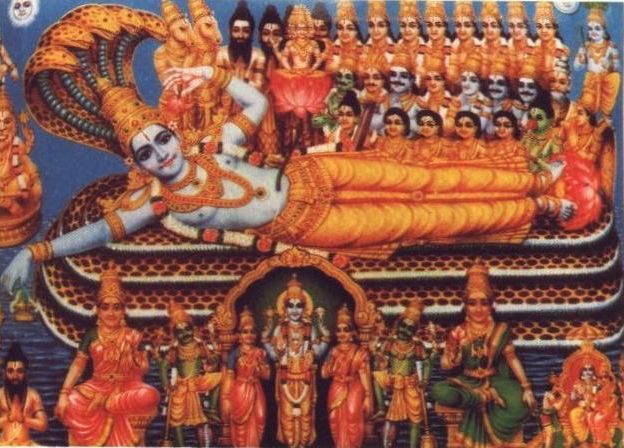
Ananta chaturdashii
CHATURDASI (fourteenth day): In Bengal, Savitri Caturdasi is celebrated on the Jyestha krsna caturdasi day. It is a vrata for women to secure blessed wifehood and longevity for their husbands. Once started, it has to be continued for 14 years. It seems to be a substitute for the Vatasavitri-vrata performed in other parts of the country. Of all the vratas assigned to caturdasi, the Anantacaturdasi-vrata (Bhadrapada sukla caturdasi)seems to be the most important and widely observed. It is also called 'Anantapadmanabha-vrata'. Lord Visnu is believed to haved to have appeared on this day as Padmanabha lying on the couch of Ananta (the thousand-hooded serpent). It is more an individual vrata for happiness that a socio-religious festival. An icon of Ananta the great serpent, and manifestation of Visnu, has to be prepared in durva grass, kept on a jar and worshipped. A thread dyed in saffron or turmeric-technically called 'doraka'-with 14 knots (symbolizing the fourteen worlds created by God) is to be offered to Ananta with a mantra and then worn. Women should wear it on the left wrist and men on the right. It may also be worn round the neck. In times of yore, Yudhisthira, the eldest son of the Pandava brothers, is said to have observe this vrata for 14 years on the advice of Sri Krsna, to overcome all his diffculties and get back his kingdom. 'O Vasudeva! Save people sunk in the great and endless ocean of samsara and make them apply themselves to the contemplaction of the form of Ananta. Salutation to Thee that hast numerous forms!' Anyone doing the same, is assured of living in the abode of Visnu.
Another vrata observed on the caturdasi day is the Vaikuntha-caturdasi vrata during Karttika suklapaksa. The legend goes that Lord Visvesvara (Siva) established the Visvesvara linga at Varanasi (Benaras) on this day after a bath in the Ganga river and observing the Pasupatavrata. According to another myth, Visnu is said to have worshiped Siva with 1008 lotuses and got the Sudarsana Cakra (the famous discus weapon) from him. Worship of Visnu in the night is the main item of this vrata. Devotees of Siva are advised to have a darsana of his linga on this day in the light of 720 oil lamps.
http://www.templesandhra.com/src/culture/FESTIVAL/caturdasi.htm A point of interest:
Ganesha Chaturthi is the birthday of Lord Ganesha on Bhadrapada Shukla Chaturti, the day is specially sacred to Lord Ganesha. The worship of Ganesha continues till Ananta Chaturdasi (Bhadrapada Shukla 14th). The festivities continue for full ten days. Thereafter the highly decorated image made of clay, is carried in big processions and immersed in sea, river or well. Ganesha is presented as the son of Siva & Parvati. During one of his birthdays, His mother, Shakti Parvati, cooked for Him twenty-one types of delicious food and a lot of sweet porridge. Ganesha ate so much that even His big belly could not contain it. Mounting His little mouse, he embarked on His nightly rounds.
His mouse suddenly stumbled upon seeing a huge snake. To adjust His belly, Ganesha put the snake on as a belt around His stomach. All of a sudden, He heard laughter emanating form the sky. He looked up and saw the moon mocking Him. Ganesha infuriated, broke off one of His tusks and hurled it at the moon. The moon hid himself behind the clouds, immediately Ganesha pronounced a curse on Him saying, "Let no one look at your face on my birthday." The symbology behind the mouse and snake and Ganesha's big belly and its relationship to the moon on His birthday is highly philosophic. The whole cosmos is likely the belly of God. Shakti Parvati is the primordial energy. The seven lokas above, seven lokas below and seven oceans, are inside the cosmic belly of Ganesha, held together by the cosmic energy kundalini symbolized as a huge snake which Ganesha ties around Him. The mouse is nothing but our ego. Ganesha, using the mouse as a vehicle, exemplifies the need to control our ego. One who has controlled the ego has Ganesha consciousness or God-consciousness. Ganesha is the God who can protect His devotees from any vigna or obstacle, and hence the name vigneshwara. He is also known as Ganapati, the head of the Ganas. He is the God of Knowledge and is invoked at the beginning of any religious function, be it a marriage; the teaching of alphabets to a child or the festival in a temple. It is believed that for the fulfillment of one's desires, His blessing is absolutely necessary. Lord Vinayaka is the Supreme Reality, who is bountiful, eternal and the endower of joy and glory to those who worship Him. He is pure Consciousness and Liberates devotees karmas. He is extolled as one Who brings well-being to the entire Universe, destroying all evil forces ever effulgent and who manisfest the different Divinities. Ananta Padmanabha vrata pooja (full):
http://www.hindunet.org/puja/texts/anant.htm
No hay comentarios:
Publicar un comentario